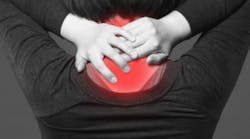Dental hygienists and musculoskeletal disorders
Are dental hygienists really advocates for preventive care?
The primary focus in the dental hygiene profession is prevention, whether it is concerning the early detection of dental caries, periodontal disease, oral cancer, or a host of other conditions. The ultimate goal is to catch health issues early before they contribute to more serious conditions. Ironically, there is a high prevalence of a preventable disorders among the dental hygiene profession. Ninety-two percent (92%) of practicing dental hygienists are currently or have previously experienced musculoskeletal pain related to the practice of dental hygiene. Our senior group project focused on identifying the relationship between physical fitness and the prevention of musculoskeletal disorders within the dental hygiene profession.1 We will discuss the results of that project here.
Musculoskeletal disorders in the dental hygiene profession
Along with the physical challenges faced in dental hygiene practice comes the risk for developing work-related musculoskeletal disorders. Although ergonomic principles for dental hygiene are seemingly common knowledge in the dental hygiene field, there appears to be a large portion of the hygiene population affected by the outcomes of poor ergonomics and improper care of the body as related to professional practice. With such a large percentage of the professional population being affected, our team decided to learn who is experiencing pain, how much they are working, whether age is a factor, and what areas of the body are commonly affected.
Study findings
Oftentimes, pain is associated with age. Interestingly enough, older hygienists are not necessarily the ones experiencing pain related to dental hygiene work. Of 172 survey respondents aged 21 to 30 years old, 15% experienced pain—the largest percentage of any age group. This is to be contrasted with the 68 respondents between the ages of 41 to 50, where 9% were experiencing pain from practice.
The amount of weekly work hours is often believed to be connected to the amount of pain experienced by hygienists. Interestingly, we found that dental hygienists who worked the most hours were not necessarily the ones experiencing the most musculoskeletal pain. Of the population of dental hygienists experiencing work-related pain, 27% worked 15 to 35 hours per week. This is to be compared to 15% of those who worked 35 hours or more per week.
Dental hygiene work is known for fine motor skills associated with the hands. It would not be odd to think that since most of the work is with fine movements in the hands and wrists that it would be the most common area to develop some sort of musculoskeletal disorder. Oddly, the wrists were only the fourth most common area of reported pain. The most common areas reported were the neck (67%), upper back (59%), and lower back (46%).
Are there preventative measures being taken in the dental hygiene profession to manage these extensive musculoskeletal problems? Treatment and management being used among the hygiene profession includes the reduction of working hours, professional massages, and usage of medication. Eighty-four percent (84%) of dental hygienists have reported reducing the number of hours of practice from a musculoskeletal disorder. 48% receive professional massages to manage musculoskeletal pain. 52% use some form of medication to help with pain related to dental hygiene practice. 75% of dental hygienists used physical fitness as prevention for musculoskeletal disorders. Three of the most common exercises used include cardio (84%), stretching (59%), and strength training (48%).
Conclusion
Just as dental hygienists work to educate their patients on the importance of following a treatment plan and performing the proper oral hygiene regimen to prevent the occurrence of various diseases, it is important for a dental hygienist to do the same when it come to working to prevent work-related injuries. Dental hygienists need to be aware of risks of developing a musculoskeletal disorder and work to prevent them. Patients are relying on their dental hygienist to be pain free because they are expecting to receive excellent care.
Reference
1. Littlewood A, Luck A, Nield A. Group research project, Utah College of Dental Hygiene. 2018.
Anika Dietrich, BSDH, was raised in Blackfoot, Idaho, and attended Brigham Young University, Idaho. In 2018, she graduated from the Utah College of Dental Hygiene with a bachelor of science in dental hygiene.
Ashley Littlewood was born and raised in South Eastern, Idaho. She received her bachelor of health science degree at Brigham Young University, Idaho, prior to her attendance at the Utah College of Dental Hygiene.
Annie Luck grew up in Vernal, Utah. She graduated from Utah State University with her associate's degree before attending the Utah College of Dental Hygiene and earning her bachelor degree. Annie has worked in the dental field as a dental assistant.

